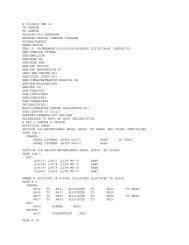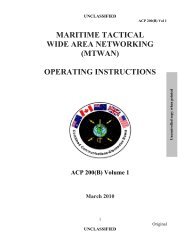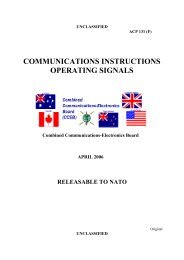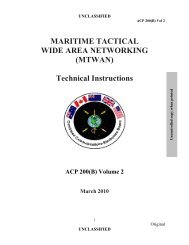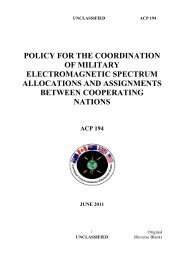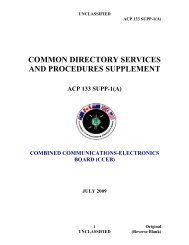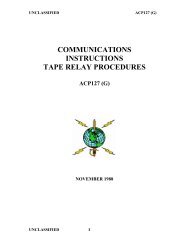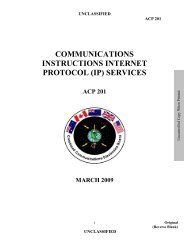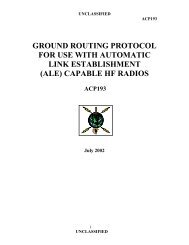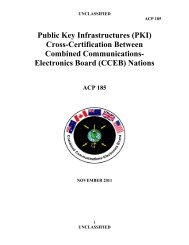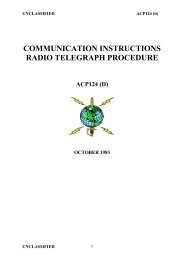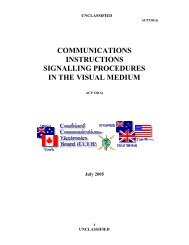ACP 122 (F) - Multilateral Planners Conference
ACP 122 (F) - Multilateral Planners Conference
ACP 122 (F) - Multilateral Planners Conference
You also want an ePaper? Increase the reach of your titles
YUMPU automatically turns print PDFs into web optimized ePapers that Google loves.
UNCLASSIFIED<br />
<strong>ACP</strong> <strong>122</strong>(F)<br />
907. When, and if possible, countries that do not mandate the use of policy identifiers on<br />
their messaging systems or are not able to allocate one, the appropriate national policy identifier<br />
should be applied at the originating national boundary.<br />
CLASSIFICATION.<br />
908. The Classification is a grading given to information or material to show the degree of<br />
damage that could result from its unauthorised disclosure and the standard of protection to be<br />
given to it. Whilst there is general agreement and understanding within the international<br />
community on the meaning of TOP SECRET, SECRET, CONFIDENTIAL and<br />
UNCLASSIFIED 2 , a number of nations do not use the term RESTRICTED. Equivalences and<br />
subsequent mapping should be in accordance with the appropriate bi-lateral agreement. It should<br />
be noted that there may be occasions when, due to the differences in bilateral agreements<br />
between nations, a message that has been forwarded to a third nation may bear a higher<br />
classification than the one assigned by the originator. This is commonly known as ‘label creep’.<br />
e.g.<br />
a. AUS sends a message with a Classification of RESTRICTED to the USA and UK.<br />
The bilateral agreement between AUS and the USA states that the USA will treat<br />
the message as CONFIDENTIAL.<br />
b. The USA replies to the message, copying UK. Both AUS and the UK receive the<br />
reply with a Classification of CONFIDENTIAL.<br />
909. Where possible, it is desirable that the original label is retained in order to clearly show<br />
the originators intent and ensure that the recipient knows how the information is to be handled in<br />
accordance with the applicable bilateral agreement. This only applies where differences in<br />
bilateral agreements may change the allocated classification (e.g. the originators label ‘CAN<br />
PROTECTED A’ could be displayed as ‘CAN PROTECTED A (RESTRICTED)’ when<br />
delivered to a UK recipient.)<br />
CATEGORIES.<br />
910. Descriptors. Whilst the CCEB uses descriptors, some of which are common to all<br />
nations, they are not intended for use in international communications and will not be passed<br />
through MM gateways.<br />
911. Codewords. Coordination is required between CCEB nations if a Codeword is to be<br />
used internationally as part of the Security Label to ensure it is managed appropriately. When,<br />
and if applicable, nations should include a field within the security label that is capable of<br />
supporting Codewords. This will enable users of messaging systems to exchange information<br />
that contain codewords common to nations. Codewords will have specific Security Enforcing<br />
Functions (SEFs) applied to them in order that the information contained in a message is<br />
distributed and handled appropriately.<br />
2 The marking or description given to information which is not protectively marked.<br />
9-2 Original<br />
UNCLASSIFIED



